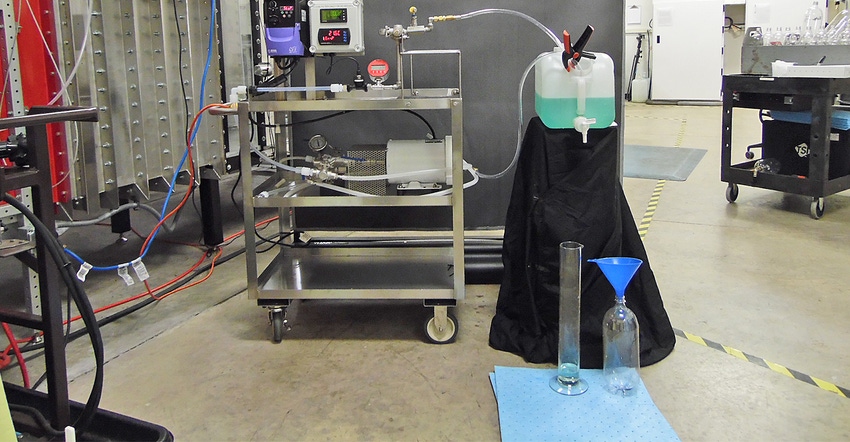July 18, 2018

There’s a science area that most farmers don’t think much about — fluid dynamics. Yet throughout every season, the principles of this area of science govern most pieces of equipment on your farm. The science of how fluids move and react in a range of situations is what brought us hydraulic power, sprayers and even proper engine lubrication. New research in this area of science is also showing that in the spraying world, some products may not stand up to the forces at work.
“In the past, if there was a small amount of driftable fines from a product, it wasn’t that major,” comments Eric Spandl, product and market development manager, WinField United. “Today, though, a small amount of fines could make a big difference.”
Concern about keeping crop protection products on the intended field has risen recently with the use of dicamba-tolerant crops. Farmers are turning to approved drift reduction agents, but it turns out some of those products may not be able to do their job — thanks to shear forces in the tank. Shear force is an area of fluid dynamics that can be a little difficult to explain.
Basically, when a fluid moves through a pipe — with the help of a pump for agitation or application — fluid on the outer edges of the pipe may move slower, due to drag, than fluid in the center of the pipe. When fluid moves at different speeds in the pipe, there is “shear” at the point of the speed change; and the force of that shear can tear at the structure of some materials in the fluid.
WinField United has a facility in River Falls, Wis., that spends a lot of time in research of products and technology, including product development. When the company was working on a new drift reduction agent, several formulations were under review.
“We ran into a foaming problem with one formulation,” recalls Dan Bissell, senior research engineer, WinField United Innovation Center. “We did a literature search and discovered that for some types of drift reduction agent formulations, there could be a problem.”
Several years ago, university researchers encountered an issue with drift reduction agents using what is called a polyacrylamide-based formulation. Those agents would break down relatively quickly when experiencing the everyday shear-force of pumping and agitation in the tank.
That literature finding turned Bissell and his colleagues toward the formulation of that new drift reduction agent. They found in that earlier work, that polysaccharide-based agents were not subject to the shear issue. And that’s the direction WinField United went with the development of its OnTarget drift reduction agent.
More research
But what about that shear-force issue? Bissell took on a project to research how shear force in the spray tank would impact the two classes of drift reduction agent. And what he found through the research is that polyacrylamide-based agents may be breaking down before they can do their job on the crop.
“This was a known problem,” Bissell notes. “But it hasn’t been explored recently, until we considered it.”
Drift reduction agents (DRA) and their efficacy is important at a time when more drift-sensitive materials are being used in the field. Bissell’s work — which involved creating a lab-sized sprayer-pump setup to measure how shear forces impacted the DRA — may be an eye-opener for the industry.
In the work, Bissell pushed four solutions through the system, plus a benchmark of dicamba alone. He used a tankmix of dicamba and glyphosate alone, then that same tankmix with two polyacrylamide DRA products; and then OnTarget, which is a polysaccharide product.
In the test, Bissell says that the polyacrylamide DRA performed worse than dicamba alone, but not as bad as dicamba-plus-glyphosate.
The WinField United Innovation Center is one of the only locations in the country with a wind tunnel where agricultural spray tests can be conducted in a closed environment, per EPA requirements. The tests were done using those mixes in that wind tunnel after the material was agitated 0, 10, 25 and 50 times through a pump.
The facility can also build on its extensive database of spray-nozzle research, which has involved work with almost 300 nozzles and data on more than 50,000 samples. “We haven’t worked with every combination of DRA and dicamba-glyphosate,” Spandl notes, “but we have worked with a lot of product.”
Bissell, who is at heart a pure research person, noted that his work is a continuation of a research conversation that started several years ago. With “hotter” products going into the tank to take on tougher weeds, knowing how all the components work — or don’t work — is important. “I’m sure there is more work to be done here, but this is what we’ve learned,” he says.
He notes that this research doesn’t say that the other DRA products don’t work, but raises concern about agitation and pump forces’ play on products in the tank.
The research is set to be published, and the official reference is: Bissell, D.C., Brown, D., Magidow, L.C., and Gednalske, J.V., “An Assessment of Polymeric Drift Reduction Adjuvant Performance after Prolonged Exposure to Pump Induced Shear.” Pesticide Formulation and Delivery Systems: 38th Volume, Innovative Application, Formulation, and Adjuvant Technologies, ASTM STP1610, B.K. Fritz and T.R. Butts, Eds., ASTM International, West Conshohocken, Pa., 2018.
About the Author(s)
You May Also Like






